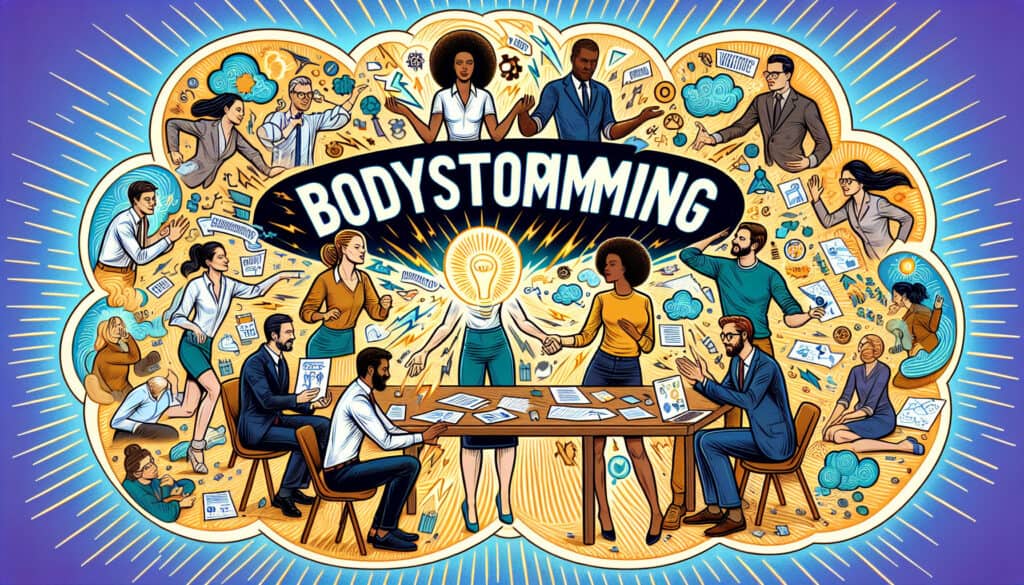A brainstorming technique that involves physically experiencing a situation to generate ideas.
- Méthodologies : Clients et marketing, Idéation, Conception de Produits
La torture corporelle

La torture corporelle
- Remue-méninges, Créativité, Pensée conceptuelle, Conception centrée sur l'humain, Idéation, Conception d'interaction, Prototypage, Expérience utilisateur (UX), User-Centered Design
Objectif :
Comment il est utilisé :
- In bodystorming, participants act out a scenario to gain a deeper understanding of the user experience. This can help to generate more empathetic and centré sur l'utilisateur ideas.
Avantages
- Provides a rich and contextualized understanding of the user experience, can lead to more innovative and user-centered ideas, and can be a fun and engaging way to brainstorm.
Inconvénients
- Can be difficult to set up, requires a willingness from participants to be physically active and to role-play, and may not be suitable for all types of problems.
Catégories :
- Idéation, Conception de Produits
Idéal pour :
- Generating user-centered ideas by physically experiencing a situation.
Bodystorming can be particularly effective in industries such as healthcare, consumer electronics, and automotive design, where understanding user interactions with products or services is paramount. During this methodology, participants may include designers, engineers, marketing teams, and actual users or stakeholders, enriching the ideation process with diverse perspectives. This approach is especially beneficial during the ideation and prototyping phases of design projects, where conventional brainstorming might fall short in capturing the realism of physical interactions or emotional responses. For instance, when designing a new dispositif médical, team members might simulate patient-doctor interactions to highlight potential obstacles in usability, thus allowing designers to address real-world concerns proactively. This methodology encourages playful experimentation, fostering an environment where team members feel comfortable exploring unconventional ideas without the constraints of traditional brainstorming methods. Engaging in bodystorming can also enhance team cohesion, as participants share experiences and insights that can lead to unexpected solutions, making it a valuable tool in the iterative design process. As teams physically immerse themselves in user situations, the tangible experience can spark innovative thoughts that may not surface through standard abstract brainstorming sessions.
Principales étapes de cette méthodologie
- Identify a specific user scenario to explore.
- Assign roles to participants, ensuring diversity in perspectives.
- Act out the scenario, focusing on behaviors, emotions, and interactions.
- Encourage improvisation and spontaneous responses during the role-play.
- Observe the dynamics and take note of key interactions and reactions.
- Debrief immediately after the enactment to discuss experiences and observations.
- Brainstorm ideas and solutions based on insights gained from the enactment.
Conseils de pro
- Encourage participants to adopt exaggerated physical movements and emotions to immerse themselves fully in the user's experience.
- Utilize props and environmental elements to simulate real-world interactions, enhancing authenticity in the scenarios.
- Incorporate targeted role-play scenarios that explore edge cases or unexpected user behaviors for deeper insights.
Lire et comparer plusieurs méthodologies, nous recommandons le
> Référentiel méthodologique étendu <
ainsi que plus de 400 autres méthodologies.
Vos commentaires sur cette méthodologie ou des informations supplémentaires sont les bienvenus sur le site web de la Commission européenne. section des commentaires ci-dessous ↓ , ainsi que toute idée ou lien en rapport avec l'ingénierie.
Contexte historique
1986
(si la date est inconnue ou n'est pas pertinente, par exemple "mécanique des fluides", une estimation arrondie de son émergence notable est fournie)

Articles Similaires
Questionnaires sur les troubles musculo-squelettiques
Tests à plusieurs variables (MVT)
Analyse de régression multiple
Systèmes de capture de mouvement
Méthode MoSCoW
Test de la médiane de Mood